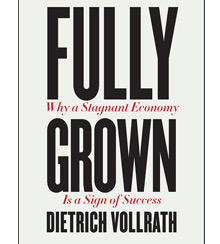The upside of slow growth
In the new book Fully Grown, economist Dietrich Vollrath argues that the recent spell of moderate growth in the U.S. is a sign of success.
Fully Grown: Why a Stagnant Economy Is a Sign of Success
by Dietrich Vollrath, University of Chicago Press, 2020
In 2016, the distinguished economist Robert Gordon published a landmark tome on the U.S. economy. The Rise and Fall of American Growth looked back admiringly on the explosion in economic output in the decades after the Civil War and lamented the subsequent fizzling out in more recent times. Among contemporary economists, Gordon has become a standard-bearer for those who believe the U.S. economy’s best days are behind it. Now, in the new book Fully Grown, an economics professor at the University of Houston, Dietrich Vollrath, tackles the same issue. But he reaches a very different conclusion. Vollrath believes that the slower economic growth since 2000 should be seen as a badge of honor, and that its main causes are consequences of the economy’s success, not its failure.
It takes some mental agility — and a conscious forgetting of how we have been taught to think about economics — to consider slower growth as a good thing. Importantly, Vollrath is not suggesting that an economy that crawls along is better for its citizens than one that expands rapidly. Yes, he would like to see the American economy grow faster. But he believes the reasons that it has grown more slowly in the past 20 years are mostly positive.
The economic puzzle behind Fully Grown is this: Between 1950 and 2000, annual growth in gross domestic product (GDP) on a per capita basis averaged 2.25 percent a year, but since 2000 it has slowed to just 1 percent. The decline cannot be explained by the severity of the 2008–09 financial crisis; there were deep recessions in the early 1970s and 1980s, too. Rather, something structural shifted. Gordon suggested that the culprit was America’s failure to innovate and produce new technology comparable to that of the motorcar and the telephone. Larry Summers, the former president of Harvard University and economic advisor to President Obama, has blamed a period of very low interest rates (pdf).
Using public data and some calculations that shouldn’t scare off noneconomists, Vollrath identifies two main factors as responsible. First, U.S. demographic trends have worsened. Like people everywhere, Americans have had fewer babies as they’ve become richer and as access to contraception has improved. The total fertility rate, Vollrath’s preferred measure, fell from more than three and a half children per American woman in the late 1950s to around two in 1980, where it has remained ever since. The effects of these social trends on economic growth have long been evident elsewhere. But they were obscured in the U.S. by the sheer size of the postwar baby boom. After 2000, baby boomers began to retire and growth in the working-age population started to slow. Vollrath estimates that this smaller contribution from human capital — in other words, slower growth in the number of people working — was responsible for around two-thirds of the decline in economic growth. He also argues, with some justification, that slower growth is a price worth paying for greater prosperity and more control for women over their reproductive rights.
Vollrath argues, with some justification, that slower growth is a price worth paying for greater prosperity and more control for women over their reproductive rights.
The second factor behind slower growth is a change in how Americans spend their money. For much of the 20th century, income was largely directed toward stuff: goods such as refrigerators, televisions, air-conditioners, and computers. As demand for these items grew, competition spurred firms to become more productive in developing and manufacturing them, while also making them relatively less expensive for consumers. But Americans are now using less of their additional wealth to buy goods. Instead they are investing in services such as healthcare, education, or travel.
This creates a problem: It is much harder to increase productivity in service industries (and thereby make them as beneficial for economic growth as consumer goods). As Vollrath explains, we can automate labor so that less of it is required to make a smartphone. But with services, the labor is an intrinsic part of the service itself. An hour with a personal trainer will always take up an hour of the trainer’s time, unless you are willing to compromise the quality of the service by purchasing a shorter session or sharing it with others.
The proportion of total spending devoted to services has been rising steadily since at least 1950. But it was only in 2000 that the share of services was large enough for the drag on productivity growth to become clear. Vollrath estimates that Americans’ preference for buying services is responsible for an additional one-sixth of the slowdown.
The remainder is likely made up of a jumble of other factors whose individual contributions are too small to measure accurately. Vollrath finds that stronger competition from China, a moderation in the rate of job turnover, a greater concentration of market power among a small group of large companies, and a decline in the number of Americans moving to more productive regions of the country may have played supporting roles in the slowing of the economy. The difference between this secondary group of factors and his primary causes is, Vollrath concedes, that these trends are generally missed opportunities. It is hard to argue that a decline in the number of Americans moving to more productive jobs is anything but a failure.
As the author of a book that’s been described as “conditionally optimistic,” Vollrath makes conclusions in Fully Grown that are a little unexpected. Like Gordon, he is doubtful that technological developments such as self-driving cars and 3D printing will be transformative for the rate of economic growth in the same manner as the car and telephone. This is partly because Vollrath believes many advances would make the production of goods even more efficient, which would accelerate the existing trend of services accounting for a higher proportion of output. He also sees the drag from unfavorable demographics lasting several more decades.
Vollrath does make one logical recommendation that could generate faster growth: more immigration. If the single biggest reason for the slowdown is moderation in the expansion of the working-age population, then adding to that population through foreign labor would seem to be beneficial for growth. Vollrath calculates that in order for the working-age population to expand at the same rate as the population as a whole (thereby removing the drag on growth), the U.S. would need an additional 255,000 working-age immigrants a year, an increase of around one-third from current immigration levels. Given that U.S. immigration has dipped in recent years, this move would simply return it to its previous trend.
It is refreshing today to read that the U.S. economy is not weak because of a trade war with China or a failure of innovation. According to Vollrath, it is growing more slowly because families have made different decisions about how to live their lives, and those decisions were only possible because of the economy’s previous success. It is conceivable, perhaps even likely, that the U.S. will never again see such a period of supercharged growth as it did in the second half of the 20th century, when it benefited from the tailwinds of life-changing innovation and abundant labor. The lesson of Fully Grown is that perhaps it doesn’t need to.
Author profile:
- Mike Jakeman is a freelance journalist and has previously worked for PwC and the Economist Intelligence Unit.





